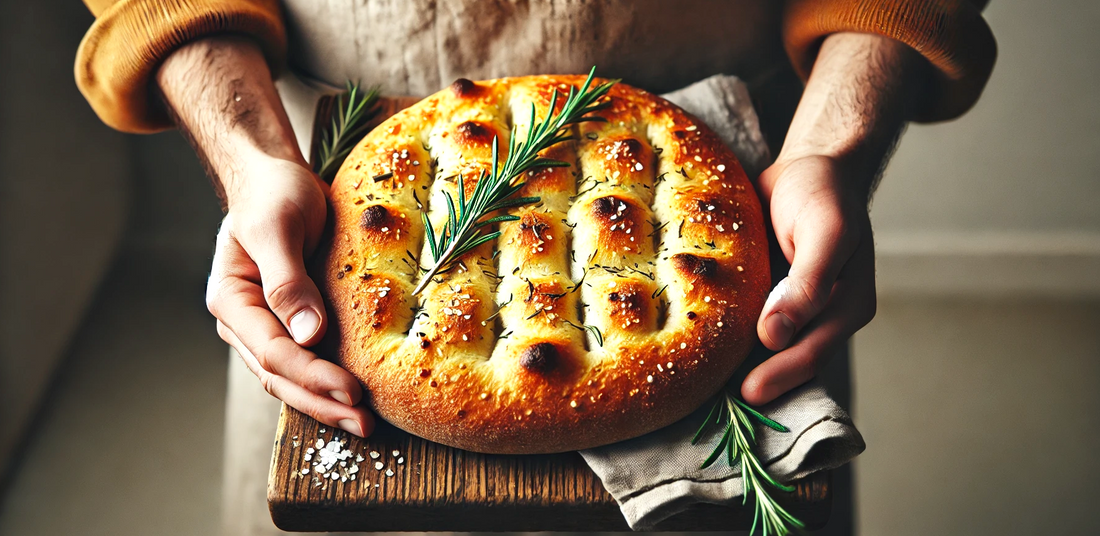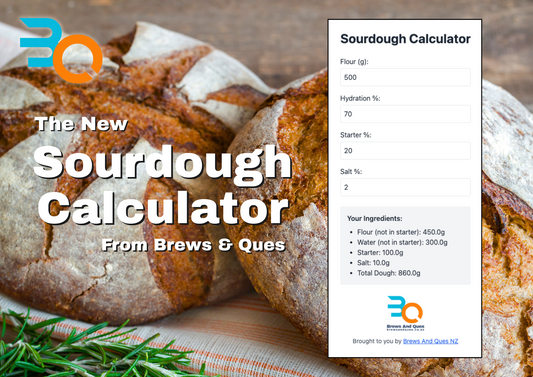Sourdough Focaccia: The Ultimate Guide
Table of Contents
- Introduction
- What is Sourdough Focaccia?
- The History of Focaccia
- Benefits of Sourdough Focaccia
- Ingredients for Sourdough Focaccia
- How to Make Sourdough Focaccia
- Tips for Perfect Sourdough Focaccia
- Variations and Toppings
- Serving Suggestions
- Storing Sourdough Focaccia
- Frequently Asked Questions
- Conclusion

Introduction
Sourdough focaccia is a delightful variation of the classic Italian flatbread, incorporating the natural leavening power of a sourdough starter. Known for its airy texture, crispy crust, and the unique tangy flavor of sourdough, this bread is a favorite among bakers and food enthusiasts. In this comprehensive guide, we'll explore everything you need to know about making sourdough focaccia, from its history and benefits to a detailed, step-by-step recipe. Let's dive in and discover the art of baking perfect sourdough focaccia.
What is Sourdough Focaccia?
Sourdough focaccia is a type of Italian flatbread made using a sourdough starter instead of commercial yeast. This method leverages the natural fermentation process to create a bread with a unique depth of flavor, a chewy crumb, and a crisp, golden crust. Traditional focaccia is known for its dimpled surface, often topped with olive oil, salt, and various herbs or other toppings. The sourdough version adds an extra layer of complexity and health benefits, making it a preferred choice for many home bakers.
The History of Focaccia
Focaccia has a rich history that dates back to ancient times. It is believed to have originated with the Etruscans, who lived in what is now Italy, around the 7th to 8th century BC. The word "focaccia" is derived from the Latin word "focus," meaning "hearth," indicating that this bread was traditionally baked on the hearth or in the ashes of a fire.
Over centuries, focaccia evolved into a staple of Italian cuisine, with regional variations emerging across the country. In Liguria, it is known as "focaccia al rosmarino," often flavored with rosemary and olive oil. In Genoa, it's common to find focaccia topped with cheese or olives. The adaptability and simplicity of focaccia have made it a beloved bread in Italy and around the world.

Benefits of Sourdough Focaccia
Sourdough focaccia offers several benefits over its commercially yeasted counterpart:
- Digestibility: The natural fermentation process of sourdough breaks down gluten, making it easier to digest.
- Nutrient Absorption: Sourdough fermentation increases the bioavailability of nutrients, including minerals like iron, zinc, and magnesium.
- Lower Glycemic Index: Sourdough bread typically has a lower glycemic index, which can help regulate blood sugar levels.
- Flavor: The sourdough process imparts a tangy, complex flavor that enhances the overall taste of the focaccia.
- Shelf Life: Sourdough focaccia tends to stay fresher longer due to the natural preservatives produced during fermentation.
Ingredients for Sourdough Focaccia
To make sourdough focaccia, you'll need the following ingredients:
- Sourdough Starter: This is the key ingredient that provides natural leavening and flavor.
- Flour: High-protein bread flour is recommended for the best texture, but you can also use all-purpose flour.
- Water: Use filtered or bottled water to avoid any chlorine that might inhibit the fermentation process.
- Olive Oil: High-quality extra virgin olive oil adds richness and flavor.
- Salt: Fine sea salt or kosher salt enhances the taste.
- Optional Toppings: Rosemary, cherry tomatoes, olives, garlic, sea salt flakes, or other herbs and spices.

How to Make Sourdough Focaccia
Step 1: Preparing the Sourdough Starter
A healthy, active sourdough starter is essential for making sourdough focaccia. Here’s how to ensure your starter is ready:
- Feed Your Starter: If your starter is stored in the fridge, take it out and feed it 12 hours before you plan to use it. Feed with equal parts flour and water.
- Check for Activity: The starter should be bubbly and have doubled in size. This indicates it's active and ready to use.
Step 2: Mixing the Dough
- Combine Ingredients: In a large bowl, mix 200g of active sourdough starter, 500g of bread flour, 375g of water, and 10g of salt. Mix until all the flour is hydrated and you have a sticky, shaggy dough.
- Rest and Autolyse: Let the dough rest for 30 minutes. This process, known as autolyse, helps develop the gluten.
Step 3: Bulk Fermentation
- Stretch and Fold: Over the next 3-4 hours, perform stretch and fold techniques every 30 minutes. To do this, grab the dough from one side, stretch it upwards, and fold it over itself. Rotate the bowl and repeat this process 4-6 times.
- Let It Rise: Cover the dough and let it rise at room temperature until it has doubled in size. This can take anywhere from 4-8 hours, depending on the temperature and the activity of your starter.
Step 4: Shaping and Proofing
- Prepare the Pan: Generously oil a baking sheet or focaccia pan with olive oil.
- Shape the Dough: Gently transfer the dough to the pan. Use your fingertips to dimple the surface, spreading the dough out to fill the pan.
- Final Proof: Cover the dough and let it proof for another 2-4 hours, or until it has visibly risen and is puffy.
Step 5: Baking
- Preheat the Oven: Preheat your oven to 220°C (430°F).
- Add Toppings: Drizzle olive oil over the dough and sprinkle with salt and your choice of toppings (e.g., rosemary, cherry tomatoes, olives).
- Bake: Bake the focaccia for 20-25 minutes, or until it is golden brown and crisp on the edges.
- Cool: Allow the focaccia to cool in the pan for a few minutes before transferring it to a wire rack to cool completely.

Tips for Perfect Sourdough Focaccia
- Hydration: Sourdough focaccia dough is highly hydrated, meaning it’s quite sticky. Don’t be tempted to add more flour.
- Oil: Use plenty of olive oil to ensure a crispy, golden crust.
- Fermentation: Be patient with the fermentation process. Longer fermentation times result in better flavor and texture.
- Toppings: Be creative with your toppings, but be mindful of the moisture content. Too much moisture can make the dough soggy.
Variations and Toppings
Sourdough focaccia is incredibly versatile. Here are some popular variations and toppings to try:
- Herbs: Rosemary, thyme, oregano, and basil.
- Vegetables: Cherry tomatoes, onions, bell peppers, and garlic.
- Cheese: Parmesan, mozzarella, and feta.
- Other Toppings: Olives, capers, anchovies, and sea salt flakes.
Serving Suggestions
Sourdough focaccia can be enjoyed in many ways:
- As an Appetizer: Serve with a selection of dips such as hummus, olive tapenade, or balsamic vinegar and olive oil.
- Sandwiches: Use it as a base for sandwiches, filled with your favourite ingredients like cured meats, cheese, and fresh vegetables.
- Soup Accompaniment: Pair it with a warm bowl of soup for a comforting meal.
- Salad Side: Serve alongside a fresh, crisp salad.

Storing Sourdough Focaccia
To keep your sourdough focaccia fresh:
- At Room Temperature: Store in an airtight container or wrap in plastic wrap for up to 2 days.
- In the Freezer: Freeze individual slices or whole focaccia in a freezer bag for up to 3 months. Thaw at room temperature and reheat in the oven.
Frequently Asked Questions
Q: Can I use whole wheat flour for sourdough focaccia?
A: Yes, you can substitute some or all of the bread flour with whole wheat flour. Keep in mind that whole wheat flour absorbs more water and may require adjustments to hydration and fermentation times.
Q: How can I tell if my dough is properly proofed?
A: Properly proofed dough should be puffy and have visible air bubbles. You can perform the "poke test" by gently pressing a fingertip into the dough; if the indentation slowly springs back, it’s ready to bake.
Q: Why is my focaccia not rising well?
A: This could be due to an inactive sourdough starter, insufficient fermentation time, or a cool environment. Ensure your starter is bubbly and active, and allow enough time for the dough to rise in a warm place.
Q: Can I add toppings before baking?
A: Absolutely! Adding toppings before baking enhances the flavor and appearance of your focaccia. Just be careful not to overload it, as too many toppings can weigh down the dough.

Conclusion
Sourdough focaccia is a versatile and delicious bread that combines the best of traditional Italian baking with the unique benefits of sourdough fermentation. With its crispy crust, airy crumb, and rich, tangy flavor, it’s sure to become a favorite in your baking repertoire. Follow this comprehensive guide to master the art of sourdough focaccia and enjoy the many variations and serving possibilities it offers. Happy baking!
Ready to Start Your Sourdough Journey?
Check out our Sourdough Starter Kit. It contains everything you need to bake delicious sourdough bread from scratch!









